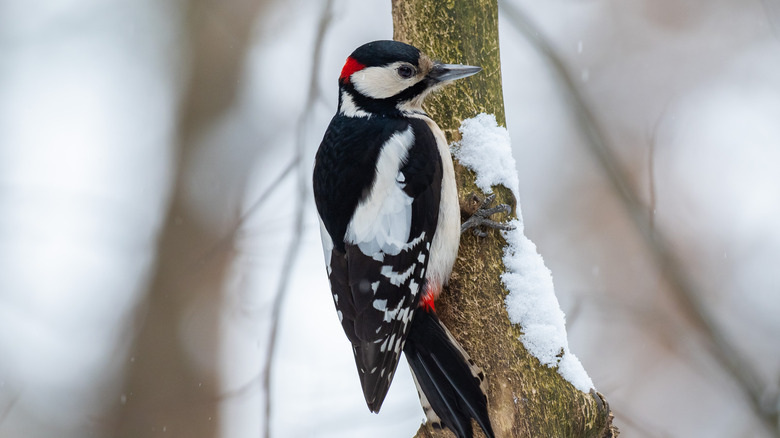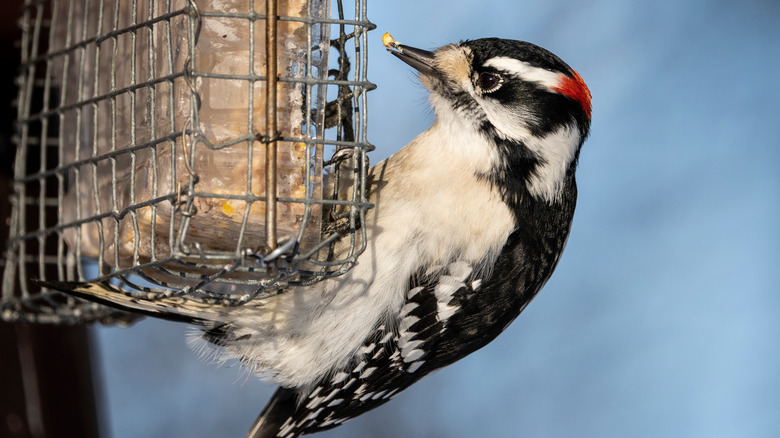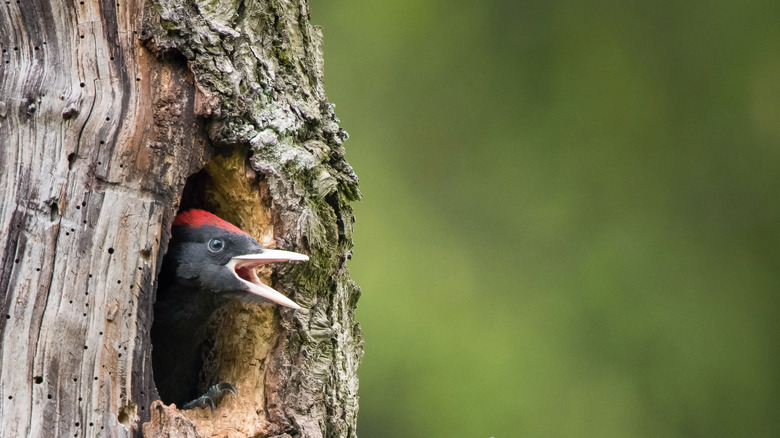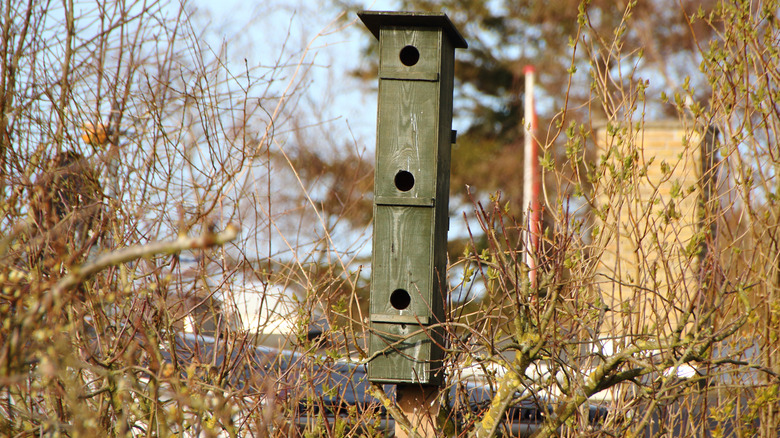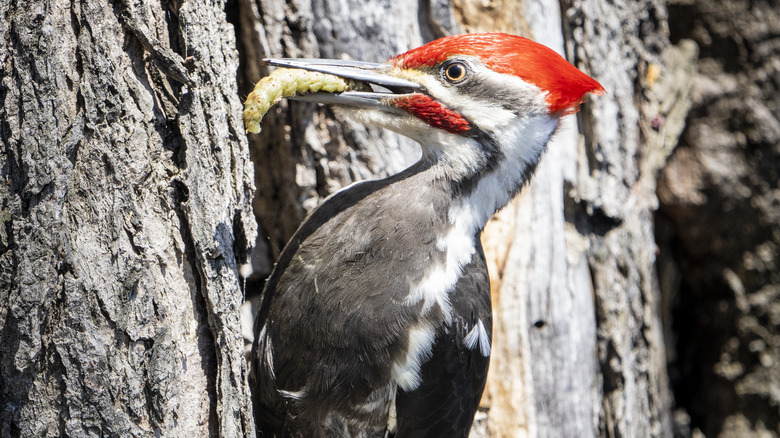How To Attract Woodpeckers To Your Yard, According To An Expert
There's something magical about the drum of a woodpecker pecking away at a tree in the backyard. Woodpeckers are not only beautiful, they benefit our gardens by keeping insect levels under control, as noted by Penn State Extension. The holes they make in our trees also help support other birds who aren't able to drill into the wood in their quest for food and shelter. Woodpeckers are also pretty interesting birds to watch.
Dr. Charles van Rees, a professional naturalist and conservation biologist who blogs at Gulo in Nature, offers insight into how homeowners can attract woodpeckers to their yards in an exclusive interview with House Digest. "Like any other animal, woodpeckers are looking for food and shelter in the wild," he says. "Since many birds, including woodpeckers, are somewhat mobile and can have relatively large territories in the breeding season, they can cover a lot of space, and that makes it easier to attract them." The good news there is that you won't have to set up your yard in a way that provides the birds with everything they need to survive, however, van Rees goes on to quip, "I would argue that it's more fun if you do." To encourage woodpeckers, van Rees offers some simple steps, including a helpful tip for making a basic DIY bird feeder.
Provide suet, nuts, and seeds for woodpeckers
Creating the ideal environment to draw woodpeckers into your yard doesn't have to be overly complex, but it's important to get to know what these birds actually need and respond best to in the environment. "Providing food for woodpeckers is much easier than providing shelter for them," says van Rees. "Most woodpeckers are die-hard suet fans, and having a nice suet feeder can go a long way in getting backyard visits, especially from suburban species like downy woodpeckers."
If you want to do more to draw them in, especially to trees closer to the home, van Rees shares a simple project. "I have also seen people nail a board full of little holes into a tree and then stuff the holes with nuts, seeds, suet, or peanut butter. I am told this was a hit even with larger woodpecker species like red-bellied or pileated woodpeckers." Of course, when you're placing food out, a common problem relates to figuring out how to attract just these birds and not other creatures who could turn into pests. For this, the placement of the wood is important. "The vertical surface makes it more likely that only woodpeckers (and maybe nuthatches) will be accessing that food, and not other bird species. Of course, squirrels are always an issue," notes van Rees.
Give woodpeckers natural shelter
If you're thinking about those cute birdhouses at the local garden center, they may not be much of an attraction to woodpeckers, shares van Rees. "Shelter for woodpeckers can be harder to come by. They typically like larger, older trees, especially ones with big dead branches. For roosting and nesting, they excavate holes in the dead part of trees and live in the resulting cavity," he says.
Homeowners with aged trees may already have a decent habitat to offer, but even these have their limits. According to the naturalist, "The best way to provide [appropriate] shelter is to have larger trees on your property and even to let older ones die (or leave dead limbs standing) so that the woodpeckers can move in. Understandably, this isn't agreeable to lots of people; many of us don't have enough room for large trees or can't afford the risk of having large limbs or entire trees come crashing down near our dwellings." Older trees away from the house may be the best options for a woodpecker residence, yet the birds will still be likely to visit feeders closer to the house so you can watch them and enjoy their antics.
Birdhouses and augmented shelters are also an option
It's possible to get some results in areas without older or hollowed-out trees by using birdhouses, but be specific on what you purchase. "Some kinds of tall birdhouses might work if secured up high and vertically along a tree's trunk," explains van Rees. If you're up for a bigger DIY project you may want to consider building one from scratch, with a long, hollow design more like that of a tree rather than the small house-like options for the robins and finches nearby.
Here's an even more nature-forward project idea from biologist van Rees. "I have seen conservation agencies remove a section of a downed tree that had woodpecker holes and then secure it to a living tree at an appropriate height (probably more than 15 feet from the ground). Since woodpeckers like to be lazy and move into holes that are pre-made," he notes, "this could be a great option too." Keep them off the ground to encourage the birds to check them out, but then monitor for squirrels who like to store just about anything in openings like this.
Attract the insects woodpeckers eat
While you can provide them with food, including suet that's filled with insects, woodpeckers are hunters by nature looking for a source of protein. For that reason, van Rees recommends supporting a more natural insect habitat. "Dead and dying trees provide another key food resource for woodpeckers: insects! Wood-boring insects and their larvae will infest dead trees, working on breaking them down, and in the process converting that dead wood into highly nutritious food for woodpeckers."
He continues, "This is as good as it gets for woodpeckers; this natural food is superior to anything we can provide. It also makes for extremely entertaining birdwatching; a woodpecker at work digging through bark makes for impressive piles of sawdust and displays of treetop carpentry." If you want to get an even closer look at these beautiful birds in action, consider placing a trail camera nearby to the structures or feeders you set up. That way, you can create the ideal environment to attract the birds and then watch from a safe distance.
